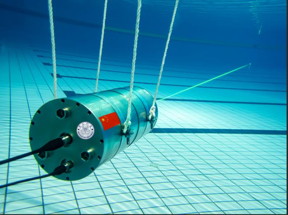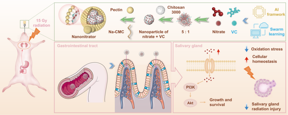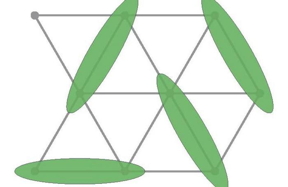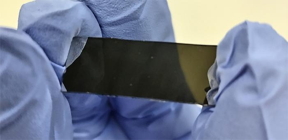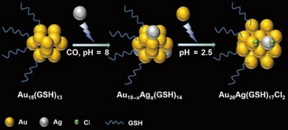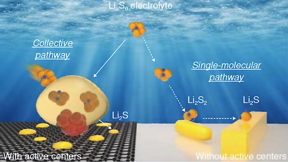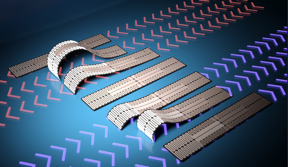Home > Press > $900,000 awarded to optimize graphene energy harvesting devices: The WoodNext Foundation's commitment to U of A physicist Paul Thibado will be used to develop sensor systems compatible with six different power sources
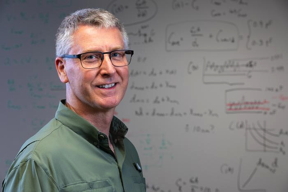 |
| Paul Thibado CREDIT University Relations |
Abstract:
U of A physics professor Paul Thibado received a commitment of $904,000 from the WoodNext Foundation, administered by the Greater Houston Community Foundation. The five-year grant will support Thibado’s development of graphene energy harvesters.
[embedded content]
This video provides a little more background:
$900,000 awarded to optimize graphene energy harvesting devices: The WoodNext Foundation's commitment to U of A physicist Paul Thibado will be used to develop sensor systems compatible with six different power sources
Fayetteville, AR | Posted on January 12th, 2024“We have successfully developed a process for building graphene energy harvesting device structures,” Thibado said, “but current structures do not harvest enough power. This proposal will allow us to optimize these structures to harvest nanowatts of power, which is enough energy to run sensors.”
Thibado and his colleagues will develop graphene energy harvesting (or GEH) technology for the following sources of power: solar, thermal, acoustic, kinetic, nonlinear and ambient radiation. As each device is developed, his team will then build a full prototype sensor system around that specific power source.
Nancy Chan, executive director of the WoodNext Foundation, said, “We’re excited to support Paul’s work. We think it’s an important step in the development of more clean energy options, as well as a potentially exciting advance in building the internet of things.”
Thibado noted that current state-of-the-art sensor technology is powered by batteries that require microwatts (a millionth of a watt) of continuous power. The goal of his project is twofold:
Reduce sensor power demand to nanowatts (a billionth of a watt) and
Power these sensors using energy harvested from the local environment.
Notably, these systems will not include batteries, which have a limited lifespan, allowing them to achieve exceptionally long operational lifetimes — potentially several decades.
“Mass use of this technology will further expand the internet of things,” Thibado explained, “which transforms ordinary sensors into smart nodes within an intelligent network. Thus, our systems will impact a wide range of applications.”
How wide? Thibado envisions these sensors being used in transportation product tracking, logistic fleet management, livestock tracking, soil sensors, agricultural climate monitoring, environmental flood alerts, disaster planning, atmospheric monitoring, predictive maintenance, manufacturing process monitoring, utility smart meters/grids, city smart parking, traffic control, city lighting, waste management, bike/scooter management, camera systems, building alarm systems, temperature control, lighting, access, wearable fitness monitoring, child tracking and medical tracking. So, pretty wide.
The installation cost of GEHs is expected to be competitive with other forms of energy supply, both large and small scale. However, GEH’s operational cost will be near zero with no costs for fuel, charging, replacement or overhaul. For example, a GEH chip could be placed in a remote temperature sensor. This chip, a component of its electronic module, will free the device from the need for external power or batteries. The chip will not require replacement, as it has the same life as other components of the device. With GEH technology, the device can be more compact, portable and safeguarded from power failure.
Additional Collaborators
A subaward of $210,000 will go to David Blaauw, a professor of electrical engineering and computer science at the University of Michigan. An expert in low-power wireless sensors and embedded systems, Blaauw will oversee fabrication of “Michigan Micro-Mote” sensors custom designed for seamless integration with each type of U of A graphene power harvester.
Blaauw will fine tune the power consumption and duty cycle of the various sensors to align with the power supplied by the U of A harvester. He will also implement a capacitive energy averaging method to support brief periods of higher power consumption.
NTS Innovations, a company specializing in nanotechnology, owns the exclusive license to develop GEH into commercial products. The company has provided funding for patenting, creating business plans, finding business partners and customer discovery.
NTS Innovations’ role over the course of the grant is to engage with customers on acceptance criteria, such as the minimum power levels needed for inclusion in products. Currently, more than 60 parties have expressed interest in testing the technology and working with Thibado and his colleagues to integrate it into their applications.
Thibado thinks his team, in cooperation with NTS Innovations, will be able to send a first-generation self-powered GEH sensor to interested customers for feedback as early as the second year of the award.
Graphene and GEHs
Discovered in 2004, graphene is a one-atom-thick sheet of graphite. Freestanding graphene has a rippled structure, with each ripple flipping up and down in response to the ambient temperature.
“The thinner something is, the more flexible it is,” Thibado said. “And at only one atom thick, there is nothing more flexible. It’s like a trampoline, constantly moving up and down. If you want to stop it from moving, you have to cool it down to 20 Kelvin.”
GEHs use a negatively charged sheet of graphene suspended between two metal electrodes. When the graphene flips up, it induces a positive charge in the top electrode. When it flips down, it positively charges the bottom electrode, creating an alternating current. With diodes wired in opposition, allowing the current to flow both ways, separate paths are provided through the circuit, producing a pulsing DC current that performs work on a load resistor.
About the WoodNext Foundation: The WoodNext Foundation manages the philanthropy of tech innovator and Roku CEO/founder Anthony Wood and his wife, Susan. Their philanthropic efforts are guided by their overall mission to advance human progress and remove obstacles to a fulfilling life. The WoodNext Foundation makes grants and investments in a variety of areas, including scientific and biomedical research, mental health, homelessness, education, nature conservation, disaster recovery and economic opportunity, with a focus on addressing root causes.
####
For more information, please click here
Contacts:
Media Contact
Hardin Young
University of Arkansas
Office: 479-575-6850
Expert Contact
Paul Thibado
University of Arkansas
Office: 479-575-7932
Copyright © University of Arkansas
If you have a comment, please Contact us.Issuers of news releases, not 7th Wave, Inc. or Nanotechnology Now, are solely responsible for the accuracy of the content.
| Related News Press |
News and information
![]() Researchers develop technique to synthesize water-soluble alloy nanoclusters January 12th, 2024
Researchers develop technique to synthesize water-soluble alloy nanoclusters January 12th, 2024
![]() Rice University launches Rice Synthetic Biology Institute to improve lives January 12th, 2024
Rice University launches Rice Synthetic Biology Institute to improve lives January 12th, 2024
![]() Development of zinc oxide nanopagoda array photoelectrode: photoelectrochemical water-splitting hydrogen production January 12th, 2024
Development of zinc oxide nanopagoda array photoelectrode: photoelectrochemical water-splitting hydrogen production January 12th, 2024
2 Dimensional Materials
![]() 'Sudden death' of quantum fluctuations defies current theories of superconductivity: Study challenges the conventional wisdom of superconducting quantum transitions January 12th, 2024
'Sudden death' of quantum fluctuations defies current theories of superconductivity: Study challenges the conventional wisdom of superconducting quantum transitions January 12th, 2024
![]() 2D material reshapes 3D electronics for AI hardware December 8th, 2023
2D material reshapes 3D electronics for AI hardware December 8th, 2023
Graphene/ Graphite
![]() Ferroelectrically modulate the Fermi level of graphene oxide to enhance SERS response November 3rd, 2023
Ferroelectrically modulate the Fermi level of graphene oxide to enhance SERS response November 3rd, 2023
Possible Futures
![]() Focused ion beam technology: A single tool for a wide range of applications January 12th, 2024
Focused ion beam technology: A single tool for a wide range of applications January 12th, 2024
![]() 'Sudden death' of quantum fluctuations defies current theories of superconductivity: Study challenges the conventional wisdom of superconducting quantum transitions January 12th, 2024
'Sudden death' of quantum fluctuations defies current theories of superconductivity: Study challenges the conventional wisdom of superconducting quantum transitions January 12th, 2024
![]() Rice University launches Rice Synthetic Biology Institute to improve lives January 12th, 2024
Rice University launches Rice Synthetic Biology Institute to improve lives January 12th, 2024
Sensors
![]() Electron collider on a chip June 30th, 2023
Electron collider on a chip June 30th, 2023
Announcements
![]() Researchers develop technique to synthesize water-soluble alloy nanoclusters January 12th, 2024
Researchers develop technique to synthesize water-soluble alloy nanoclusters January 12th, 2024
![]() Scientists use heat to create transformations between skyrmions and antiskyrmions January 12th, 2024
Scientists use heat to create transformations between skyrmions and antiskyrmions January 12th, 2024
![]() Bridging light and electrons January 12th, 2024
Bridging light and electrons January 12th, 2024
![]() Development of zinc oxide nanopagoda array photoelectrode: photoelectrochemical water-splitting hydrogen production January 12th, 2024
Development of zinc oxide nanopagoda array photoelectrode: photoelectrochemical water-splitting hydrogen production January 12th, 2024
Food/Agriculture/Supplements
![]() Silver nanoparticles: guaranteeing antimicrobial safe-tea November 17th, 2023
Silver nanoparticles: guaranteeing antimicrobial safe-tea November 17th, 2023
![]() Night-time radiative warming using the atmosphere November 17th, 2023
Night-time radiative warming using the atmosphere November 17th, 2023
![]() DGIST and New Life Group launched a research project on "Functional beauty and health products using the latest nanotechnology" May 12th, 2023
DGIST and New Life Group launched a research project on "Functional beauty and health products using the latest nanotechnology" May 12th, 2023
![]() Manufacturing advances bring material back in vogue January 20th, 2023
Manufacturing advances bring material back in vogue January 20th, 2023
Environment
![]() Billions of nanoplastics released when microwaving baby food containers: Exposure to plastic particles kills up to 75% of cultured kidney cells July 21st, 2023
Billions of nanoplastics released when microwaving baby food containers: Exposure to plastic particles kills up to 75% of cultured kidney cells July 21st, 2023
![]() A non-covalent bonding experience: Scientists discover new structures for unique hybrid materials by altering their chemical bonds July 21st, 2023
A non-covalent bonding experience: Scientists discover new structures for unique hybrid materials by altering their chemical bonds July 21st, 2023
Grants/Sponsored Research/Awards/Scholarships/Gifts/Contests/Honors/Records
![]() 'Sudden death' of quantum fluctuations defies current theories of superconductivity: Study challenges the conventional wisdom of superconducting quantum transitions January 12th, 2024
'Sudden death' of quantum fluctuations defies current theories of superconductivity: Study challenges the conventional wisdom of superconducting quantum transitions January 12th, 2024
![]() 2D material reshapes 3D electronics for AI hardware December 8th, 2023
2D material reshapes 3D electronics for AI hardware December 8th, 2023
- SEO Powered Content & PR Distribution. Get Amplified Today.
- PlatoData.Network Vertical Generative Ai. Empower Yourself. Access Here.
- PlatoAiStream. Web3 Intelligence. Knowledge Amplified. Access Here.
- PlatoESG. Carbon, CleanTech, Energy, Environment, Solar, Waste Management. Access Here.
- PlatoHealth. Biotech and Clinical Trials Intelligence. Access Here.
- Source: http://www.nanotech-now.com/news.cgi?story_id=57445
- :has
- :is
- :not
- $UP
- 000
- 10
- 12th
- 17th
- 20
- 20th
- 21st
- 26
- 30th
- 3d
- 3rd
- 60
- 7th
- 8th
- a
- Able
- acceptance
- access
- accuracy
- Achieve
- acoustic
- addressing
- administered
- advance
- advances
- Agricultural
- AI
- alarm
- alerts
- align
- allow
- Allowing
- Alloy
- also
- Ambient
- an
- and
- Anthony
- applications
- AR
- ARE
- areas
- around
- Array
- AS
- At
- atmospheric
- atom
- autonomous
- averaging
- award
- awarded
- away
- Baby
- back
- background
- batteries
- BE
- Beam
- Beauty
- being
- between
- biology
- biomedical
- boasts
- both
- Bottom
- bring
- build
- Building
- bulletproof
- burn
- business
- business plans
- but
- by
- camera
- CAN
- capacitive
- carbon
- Catalyst
- causes
- Center
- CGI
- challenges
- chan
- charge
- charged
- charges
- charging
- chemical
- chemistry
- child
- chip
- City
- clean
- clean energy
- click
- Climate
- co2
- cold
- collaborators
- colleagues
- color
- COM
- comment
- commercial
- commitment
- community
- compact
- company
- compatible
- competitive
- component
- components
- computer
- computer science
- Condensed matter
- conducted
- CONSERVATION
- constantly
- consumption
- Containers
- content
- continuous
- control
- conventional
- Conversion
- Cool
- cooperation
- Cost
- Costs
- could
- course
- create
- created
- Creating
- credit
- criteria
- Current
- Currently
- custom
- customer
- Customers
- Cut
- cycle
- David
- dc
- Death
- decades
- December
- del
- Demand
- demonstrate
- designed
- develop
- developed
- Development
- device
- Devices
- different
- direct
- Director
- disaster
- discover
- discovery
- do
- doesn
- down
- dramatically
- each
- Early
- Economic
- Education
- efforts
- electrical engineering
- Electronic
- Electronics
- embedded
- Emissions
- end
- energy
- engage
- Engineering
- Engines
- enhance
- enough
- Environment
- environmental
- envisions
- Ether (ETH)
- example
- exceptionally
- excited
- exciting
- Exclusive
- executive
- Executive Director
- Expand
- expected
- experience
- experiments
- expert
- explained
- Exposure
- expressed
- external
- Failure
- Fayetteville
- feedback
- films
- finding
- fine
- fitness
- FLEET
- fleet management
- flexible
- Flips
- flood
- flow
- fluctuations
- Focus
- following
- food
- For
- forms
- Foundation
- Free
- from
- Fuel
- fulfilling
- full
- functional
- fundamental
- funding
- further
- futuristic
- GAS
- gif
- Go
- goal
- grant
- grants
- Graphene
- greater
- greenhouse gas
- Group
- guided
- harvest
- Harvesting
- Have
- he
- Health
- help
- helped
- higher
- his
- homelessness
- houston
- However
- http
- HTTPS
- human
- Hybrid
- hydrogen
- if
- Imaging
- Impact
- implement
- important
- improve
- in
- Inc.
- include
- Including
- inclusion
- information
- innovations
- Innovator
- installation
- Institute
- integrate
- integration
- Intelligent
- interest
- interested
- International
- international space station
- Internet
- internet of things
- into
- Investments
- IT
- ITS
- January
- jpg
- July
- june
- just
- Kelvin
- kidney
- Kills
- lab
- large
- laser
- latest
- launched
- launches
- lenses
- Level
- levels
- License
- Life
- lifespan
- light
- Lighting
- like
- Limited
- links
- little
- load
- local
- Long
- maintenance
- MAKES
- management
- manages
- manufacturing
- material
- materials
- Matter
- May..
- mechanical
- medical
- mental
- Mental health
- metal
- methane
- method
- Michigan
- millions
- minimum
- Mission
- module
- monitoring
- more
- moving
- multiple
- nanotechnology
- Natural
- Natural Gas
- Nature
- Near
- Need
- needed
- negatively
- net
- network
- New
- news
- nicholas
- no
- Noble
- nodes
- noted
- nothing
- novel
- November
- now
- obstacles
- of
- offset
- on
- ONE
- only
- opened
- operational
- opportunities
- Opportunity
- opposition
- Optimize
- Options
- or
- ordinary
- Other
- our
- over
- overall
- Overhaul
- oversee
- owns
- parking
- parties
- partners
- paths
- Paul
- performs
- periods
- philanthropic
- PHILANTHROPY
- PHP
- Physics
- placed
- planning
- plans
- plastic
- plato
- Plato Data Intelligence
- PlatoData
- player
- please
- Pollution
- portable
- positive
- positively
- Post
- posted
- potent
- potentially
- power
- powered
- predictive
- press
- Press Release
- pretty
- probe
- process
- producing
- Product
- Products
- Professor
- Progress
- project
- proposal
- prototype
- provided
- provides
- Quantum
- quantum technology
- Radiation
- range
- received
- recovery
- relations
- release
- released
- Releases
- remote
- remove
- Renowned
- replacement
- require
- research
- researchers
- response
- responsible
- return
- Rice
- Ripple
- Rival
- robots
- Role
- Room
- root
- Run
- s
- safeguarded
- Said
- same
- Save
- Scale
- Science
- scientific
- scientists
- seamless
- Search
- Second
- send
- sense
- Sensitivity
- sensor
- sensors
- separate
- setup
- several
- Share
- sheet
- simultaneously
- single
- SIX
- Skin
- small
- smart
- So
- Soft
- soil
- solar
- solely
- solid
- something
- Source
- Sources
- Space
- space station
- specializing
- specific
- speed
- start
- state-of-the-art
- station
- Step
- Stop
- strength
- strong
- structure
- structures
- Study
- submit
- Successfully
- such
- sudden
- Superconductivity
- supplied
- supply
- support
- Susan
- suspended
- synthesize
- synthetic
- system
- Systems
- T
- Tandem
- team
- tech
- technique
- Technologies
- Technology
- Testing
- than
- that
- The
- the world
- their
- Them
- then
- There.
- thermal
- These
- things
- think
- Thinks
- this
- Through
- Thus
- times
- to
- tool
- tools
- top
- toward
- Tracking
- traffic
- transformations
- transforms
- transportation
- two
- type
- Ultra
- unique
- university
- University of Michigan
- us
- use
- used
- uses
- using
- utility
- variety
- various
- Video
- want
- Waste
- Wave
- Way..
- ways
- we
- wearable
- WELL
- when
- which
- wide
- Wide range
- wife
- will
- wireless
- wisdom
- with
- within
- wood
- Work
- working
- world
- Yahoo
- year
- Yield
- you
- youtube
- zephyrnet
- zero










